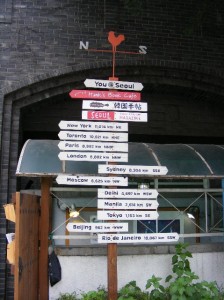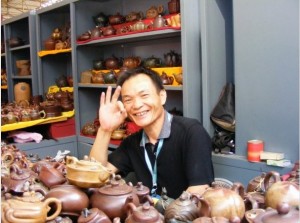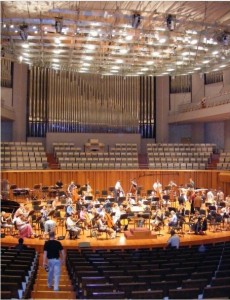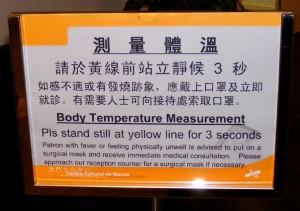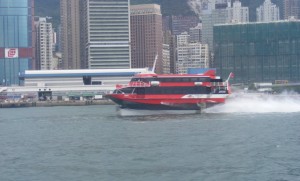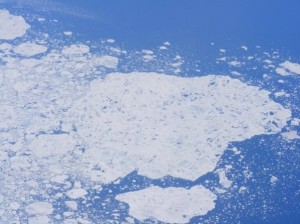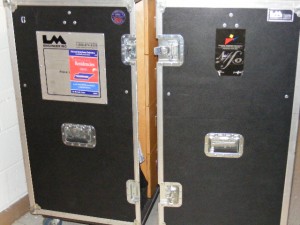National Symphony in China
Saturday, June 20, 2009: Home at Last
Yesterday morning (was it only yesterday?) I went sightseeing in Seoul, in the Gyeongbok Palace area of the city. I found lovely quiet lanes, views of the mountains in the distance, and saw part of the changing of the guard at the palace. In the afternoon when I got back to the hotel, I ate a scallion pancake and treated myself to kiwi gelato. In the evening we had a runout concert to Goyang, where Hyun-Su Shin played the Mendelssohn concerto with us. She wowed the audience, and played an encore as well. We all hoped the bus ride back to the hotel would go more quickly since it was late at night, but Seoul is plagued with horrendous traffic even at 11pm. Most of us didn’t fall into bed until midnight.
There was a 6am luggage call, a quick breakfast, hotel checkout, and another hour on the bus to get to the airport this morning. Then the endless flight to get back to Washington. When we arrived, the pilot informed us there would be a 40 minute delay, but after that many hours in the air, what’s a few more minutes? I watched two movies, read an entire book, ate the two meals and one snack that we were served, even napped 2-3 hours and still had hours to fill before we landed.
I don’t know if there’s an easy way to summarize a concert tour/cultural exchange such as we just finished. I was told that our sponsors at Dow felt it was worth the money they spent to have our orchestra in China. We certainly appreciated seeing China again after our last tour there, ten years ago. The halls we played in were first class, and the audiences were appreciative.
There are personal changes that happen when you’ve been part of this kind of experience. Most of us took lots of photographs and ate new foods. When you get home you don’t take things so much for granted, at least not for the first few days, such as having several rooms in your house, or laundry facilities and air conditioning. Many people in the orchestra were inspired to learn more about Korean or Chinese history, or paintings, or music, or the languages. And of course we have our shared experiences, such as taking the maglev train, or visiting the Great Wall. We didn’t get to share those with our families, we shared them with our colleagues. Those experiences become part of the “orchestra lore” that every orchestra builds up.
I hope that each of you who virtually followed along feel that you were part of our trip as well. Until the next tour… Yvonne Caruthers
Friday, June 19, 2009: Seoul, Korea
Tonight is our last concert of the tour, in Goyang, a suburb of Seoul. Last night we played at the Seoul Arts Center, another beautiful hall. It was our last concert with Nicolaj Znaider (we perform with a young Korean violinist this evening, Hyun-Su Shin.) It was also the last time we played Daniel Kellogg’s new piece Western Skies. The Seoul audience was by far the most receptive to his piece of any audience we’ve played it for so far. I was sorry he had gone back to the US after our Xi’an concert–he would have loved to hear last night’s applause for his piece.
The Seoul Arts Center is a spacious (rather than compact) hall. I’m not sure exactly how many seats it has, but it felt larger than the other halls on this tour. Yet there is a “sweet spot” on stage, and Mr. Znaider seemed to be standing exactly in the center of it for his concerto. Every note spoke clearly, and he reveled in the chance to make the hall work for him–at the end the crowd roared their approval. He played a Bach encore, and it was a joy to hear how softly and elegantly he could play, and even those in the farthest corners could hear every detail. We’re sure going to miss these halls when we get home: we have performances of Also Sprach Zarathustra next week in Washington.
In my last postcard I mentioned that I was going to take the maglev train from the terminal near our hotel to the Shanghai airport. What an amazing ride! As you can see from the photo, we reached the speed of 431 km/hr, but almost as soon as we reached that speed it was time to start slowing down to arrive at the airport station. The trip lasted less than 7 minutes, and those of us who took it wondered when we can hope for maglev service between Washington and NY, or NY and Chicago.
Today here in Seoul we have the day free until we leave for the concert this evening. There is a lot of great food to be eaten in this city, even if one often has to rely on pointing to the display dishes. And there is a lot of great shopping here too, including every conceivable product made from ginseng. It’s a bit tricky to figure out prices since there are so many zeroes in use at the moment. I just had to take a photo of coffee prices at the airport because they sound so daunting, but KW1000 is only about 80 cents.
Wednesday, June 17,2009: Shanghai to Seoul
Our largest sponsor for this tour is the Dow Chemical Company, and the reception after last night’s concert was the first time most of the orchestra got to meet people from Dow. Jim McIlvenny, a VP from Dow and the man most responsible for Dow’s sponsorship of our tour, gave a short speech at the reception about the need for cooperation between China and the US. He thinks the arts are a great vehicle for helping people realize their similarities rather than their differences. He also observed that China needs creative solutions for the hurdles it faces, not just technical ones.
The hall where we performed, the Oriental Arts Center in Pudong, is as acoustically pleasing as the hall in Beijing. It was easy to hear ourselves and each other, the sound had a bloom to it…..AND the hall was sold-out. What a nice send-off as we leave this country!
Yesterday afternoon two of my colleagues (Aaron Goldman, flute, and Steve Dumaine, tuba) and I performed at a school in Shanghai. The NSO had been asked by Dow if it was possible to show students the connections between math/science and music. Since that’s a program I do regularly at the Kennedy Center, I was contacted. Unfortunately, there was a misunderstanding about what age would attend our program. I had specified that my program was for ages 9+, and was assured that though there might be students a bit younger, there might also be high school students, and since Chinese students are on average more advanced than American students when it comes to math-science, I should prepare a content-rich program. However, when the students arrived for the concert we were told “yes, they are 6-8 years old.” Luckily I had brought along my carbon fiber cello. Jim McIlvenny’s eyes lit up when I demonstrated it for the students, as Dow makes carbon fiber. After the students left he came over to inspect my cello, so I let him play it. It’s always a magical moment when an adult puts bow to string for the first time and coaxes a sound from the instrument.
There wasn’t much time for me to explore Shanghai, which is a pity, since it’s one of the great cities of the world. I did manage to catch a glimpse of Century Park (near our hotel), which has a famous “flower clock.” It’s not merely decorative, it also shows the time. I also took the subway to the older part of the city, near the Bund, which is the colonial part of the city along the Huangpu River. But there is a lot of construction along the Bund as the city prepares for Expo 2010, so it wasn’t possible to even see the river.
The subway costs 4 yuan in Shanghai (twice as much as in Beijing), which is about 70 cents, and there is a bit less English to guide the non-Chinese, but it’s still very easy to use. At the concert last night it was fun to compare notes with my colleagues about areas of the city they had explored.
Today we leave for Seoul, Korea, where we have our final two concerts for this tour. A few of us are going to take the maglev train to the airport. It’s the fastest train in the world, speeding along at 400+ km/hr, making the trip from the terminal in Pudong to the airport in 7 minutes. The rest of the NSO is taking a bus from the hotel to the airport–the estimated time for that trip is about 45 minutes.
Tuesday, June 16, 2009: Shanghai
It was hot in Xi’an on Sunday, nearly 100. The local people told us, “this is just the beginning of summer, it gets much hotter.” Like all large Chinese cities, Xi’an has bad traffic. And it seemed that nearly everywhere I looked I saw construction. I wish I could say that we overcame the heat and noise and dust to play a great concert, but I don’t think that concert will go on the record books as being our best.
I went for a walk early Monday morning, hoping to find a breath of cool air. It was cooler, and there was less traffic, so I walked to two of Xi’an’s most famous sights: the Drum Tower and the Bell Tower. I also stumbled upon a mural showing the history of China (the modern era occupied less than 1/3 of the mural).
Xi’an is one of the last walled cities anywhere, and the entire old city wall is intact, spectacularly so. But surely the most compelling reason to visit Xi’an is its proximity to the Museum of the Terra-Cotta Warriors. I don’t think it’s hyperbole to say that visiting this site is approximately equivalent to visiting King Tut’s tomb before its contents were moved to museums. I mentioned in a previous post that a new group of warriors has recently been unearthed at the museum. But it’s not just at the museum that new finds are being made. Our guide told us that the Xi’an airport has banned any new construction around it because more artifacts have been discovered there.
Unfortunately our visit to the museum was brief as we had a flight to catch to Shanghai. We landed at 6:30 pm in what looked like thick fog–the street lights were already on. I’m not familiar with the weather here, but there’s a distinct possibility that this is not fog, but smog.
I’m scheduled to visit a school today to perform with two of my colleagues, Aaron Goldman, flute, and Steve Dumaine, tuba. Our tour sponsors requested outreach programs here in Shanghai, so my group is doing one event, and 4 violinists are doing a couple of events as well.
Sunday, June 14, 2009: Travel from Beijing to Xi’an
A very exciting development in just the past two days is that more terra-cotta warriors have been discovered at Xi’an. We have a group tour of the museum in Xi’an on Monday, and we’re hoping to see one of the newly-excavated warriors. A trove of coins was also found in the same area.
As I write, it’s morning here in Beijing, but at home it’s prom night for the daughter of Glenn Turner, who’s on our stage crew. What father likes to miss his daughter’s prom? Glenn said he and his wife debated whether he should travel with the NSO for this tour (he’s also missing her graduation a few days from now) but they are facing hefty college tuition in the fall, so Glenn came with us.
Yesterday was the orchestra’s day off in Beijing. Most of the group took a tour to a section of the Great Wall. They reported that it was hot and very, very crowded, but still worth the visit. A small group of intrepid travelers took their own trip to the Wall, to a less popular site which required strenuous hiking. I heard they thoroughly enjoyed it.
Some of us who visited the Wall 10 years ago chose to stay here in Beijing to see other sites. I chose the Panjiayuan “antiques” market (where there are few antiques in spite of the name). It’s one of the last open-air markets in the city, as many of the other famous markets, such as Silk Alley, were moved indoors to spruce up the city for the Olympics.
Panjiayuan is a noisy, bustling place, where the vendors are surprisingly polite. I only had one or two grab me by the arm trying to keep me at their spot to buy something. But I learned (by the time I left) that if you stop and pick up an object to inspect it more closely, you’d better be ready to name a price. It’s OK to look, even to look for a long time, but if you touch it, you’d better be ready to bargain.
I have read that if you pay more than 20% of the asking price, you’re paying too much, but I usually ended up with a 50% “discount” on my purchases, which doesn’t really bother me because most of the vendors need the money more than I do, and I was having a great time. I even bought a small erhu, the Chinese folk instrument with two strings. The man I bought it from demonstrated that the bow (which is caught between the two strings) is pulled away from the player’s body to make a sound, the opposite of instruments in the string family.
One section of the market reminded me of Costco or Sam’s Club in the US. Many times at my local Costco I’ve seen owners of convenience stores buying sodas in bulk, which they then sell singly at their corner stores. The same is true here in Beijing at the tourist sites. The owners buy things at Panjiayuan wholesale (beads, jade bracelets, etc.) and then sell them at their own store. It was also eye-opening to see that many of the vendors at the wholesale market had business cards advertising which factories they have access to.
After a tiring three hours at the market I was an easy mark for the pedicab driver who offered me a lift to the nearest subway station (about a mile away). It was one of the most exhilarating rides I’ve ever taken. I wished it would last longer, but then remembered it was costing me $3, while the subway ride back to my hotel (3 trains, over 30 minutes) would cost 30 cents.
In the afternoon I decided to head out of Beijing for the Summer Palace, one of the best examples of Chinese garden architecture in the world. It was hot and muggy in the city, threatening to rain and I was in search of calm and beauty to replace the bustle of this huge city. I wasn’t the only person to have this idea.
The crowd at the Summer Palace on a hot Saturday afternoon reminded me of the crowds in Washington, DC for the cherry blossom festival. There is really no escape from the fact that the population of China is more than 1.3 billion. However, in the US if you go to a crowded tourist site, such as Yellowstone Park, and leave the main roads and trails by even a few yards, the crowds thin dramatically. The same is true here. It was amazing how refreshing even a short visit was.
I’d better get breakfast, since we have an early departure for Xi’an, where it’s even hotter than it is here in Beijing. Yesterday it was 37 C in Xi’an, only 30 here in Beijing. In case you have trouble converting to Fahrenheit, 37 C is an easy one to remember, as it’s your average body temperature!
June 11, 2009: First concert in Beijing
During the 2008 Olympics everyone became familiar with the National Cultural Center in Beijing. It looks like an egg sitting in water. But I don’t recall seeing images looking out from within, which is an equally striking view.
And then there is the stage–wow! (There’s actually more than one stage in this huge complex…)
We had a rehearsal Thursday afternoon, then our first Beijing concert in the evening. The sound onstage is wonderful. It’s clear, spacious, and resonant, but not overwhelmingly so.
At first we thought it would be a loud stage, since there are lots of hard surfaces. But when we began to play it became obvious that the best part of the hall is that you don’t have to work very hard to make a glorious sound. The least bit of bow, the softest attack–the sound carries. And when we’d hit a fff chord it wasn’t deafening because the room is big enough for that amount of sound.
The two halls this one reminded me of were Davies Hall in San Francisco, and the hall in Birmingham, England. But architecturally, I think the Beijing hall beats them both. For instance, there are marble floors throughout the public areas: I counted at least six varieties, and I wonder if they are Chinese marbles. There are exhibition spaces for art exhibits. (Of course there is a gift shop and a cafe.)
But my favorite feature is the water surrounding the building. When we arrived (at an entrance that would allow easy access to the backstage facilities) I didn’t even see the pool (moat?), and we walked down a long ramp from the sidewalk to the entry door. But just inside the door was a beautiful foyer, with flowers and greenery and a huge skylight with dappled light pouring down. Wait–is that water overhead? Yes, it is. The pool that surrounds the building is actually only a few inches deep, and it flows over the skylights that I just mentioned, so that the foyer we entered is “underwater.” The effect is magical! (just like the sound onstage…)
The concert went well. We opened with Daniel Kellogg’s piece (he flew in for the occasion), and the audience received it with polite applause. Mr. Znaider’s Tchaikovsky violin concerto wowed the audience, so he played an encore by Bach. That was a joy to listen to, and I’m sure it was a joy for him to play–he could play as quietly as if he were in his own home and the audience heard every detail. More magic.
After our performance of the Dvorak 7th symphony, we played Stars and Stripes for an encore (we’ve used it for that purpose for years, even in countries where we were booed for playing it) and some people in the audience started clapping along just as they do in the US, but they soon stopped. However, the roar of applause at the end told us that this was a good encore to play in Beijing.
So I will close with a political story. Today in a tourist-y shop I had a fun bargaining experience with a young man. We both were laughing about the whole exchange, as bargaining is a social game in this country. When we finished he said, “Where are you from?” I said, “America.” He said, “I know, but where are you from?” I said, “the United States,” and he said, “I mean what city are you from?” I said, “Washington” and he shook his head, so I said, “Obama!” and he threw his arms over his head and shouted, “Obama!”
Wednesday, June 10, 2009: Arrival in Beijing
We had heard that flu scanning was even more thorough in Beijing than in HK and Macau, but I don’t think any of us had any idea how thorough. “Ladies and gentlemen, please remain in your seats until the health inspectors have scanned each person.” Can you imagine if you heard that announcement on a flight that has just landed in the US? How many people would would remain seated?
We dutifully remained in our seats while two health inspectors (wearing face masks) came onto the plane. They each carried a device about the size of an asthma inhaler, which they pointed at a person’s forehead for about 2 seconds. Then they pointed it at the next person’s forehead…they could do a row very quickly and it wasn’t long before we were allowed to get off the plane. (We had already filled out the usual immigration form and the health screening form.)
The new Beijing International Airport is huge, probably as big or bigger than Dallas-Fort Worth, which is the most sprawling complex I can think of in the US. There was even a sign on the wall telling us how far we had to walk to get to the immigration check point.
The people at the checkpoint were all wearing face masks too, and I had a moment of panic when the official I was assigned to suddenly looked at me and said, “I must see your boarding pass.” Did I even have it anymore? Usually I toss it out with my trash at some point during the flight. Miraculously, I dug in the pocket of my carry-on and there it was. (What would have happened if I hadn’t found it?) He compared the seat listed on my boarding pass with the seat I had written on my health screening form and let me go.
Yes, there is more traffic in Beijing than there was ten years ago when we visited. Fewer bikes, more cars. But pollution doesn’t seem bad, and the weather is quite a bit cooler than in Macau, certainly much, much less humid.
I can’t wait for our rehearsal and concerts (Thursday/Friday) in the new concert hall. I made a quick trip to Tiananmen Square last night and the contrast in architecture between the new concert hall and the old buildings of the Forbidden City is stark, but not as jarring as you might think, maybe because we’ve seen images of both on TV so often during the Olympics.
First concert, Macau Cultural Center
Tuesday, June 9, 2009
We had a rehearsal this morning in Macau, and it felt good to be playing again after all the traveling we’ve done. We had a pre-tour rehearsal last week in Washington, but one person in the orchestra was playing with us for the first time today, cellist Drew Owen. Drew was called by our personnel manager last Wednesday and asked if he could possibly come with us to Asia for two weeks. (David Howard, whom Drew is replacing, might possibly have a herniated disc and is in a lot of pain.)
This evening we were thrilled to see that nearly every seat was occupied. The Wagner “Overture to Die Meistersinger” was greeted with lukewarm applause, but the Mendelssohn Violin Concerto was another story all together. Nicholaj Znaider plays the piece superbly and the audience rewarded him with enthusiastic applause. I can only imagine what it’s like to be him–ready to step in at a moment’s notice to play two concertos with a touring orchestra. (Several of us remember that Znaider stepped in at the last minute when Joshua Bell had to cancel several appearances with us during our last European tour.) The audience here was also very appreciative of the Tchaikovsky 5th Symphony, which we played after intermission. We played 2 encores: Copland’s “Celebration Dance” from Billy the Kid, and a “Chinese encore” simply titled “Peach Blossom.” I must admit to a certain misgiving when we were playing “Peach Blossom”–what if we were playing it twice too slow?
In May the H1N1 epidemic made front page headlines in the US. In Mexico City the government shut down the city for several days to keep people from congregating and spreading the virus. The Chinese have already dealt with SARS and a few outbreaks of avian flu, so they have a different way of handling the current outbreak. I’ve mentioned that we’ve had to fill out health forms every time we’ve gone through immigration, and that we’ve gone through temperature scanning machines.
This morning we were each given a temperature scan before we could enter the hall for our rehearsal. We had to pause for three seconds by a sensor at the entrance (borrowed from the set of Wall-E?). If we “passed” the test, a sticker was put on our ID badge so that it was easy to check our status. At tonight’s concert, the same system was in place–for the entire audience! I suppose that schools and libraries, etc., are also using these scanners, so most of the population is being checked on a regular basis. With this kind of vigilance it doesn’t seem likely that a virus will easily overwhelm the population. I’ve also noticed, as I’ve been walking in Macau, that about 15-20% of the population wear a face mask. What I don’t know is whether those people are trying to protect themselves from getting the flu or protect others from catching it from them.
Tomorrow we travel to Beijing, so I’m sure we’ll be scanned again.
We’re supposed to have internet access from our hotel room, but I couldn’t get mine to work properly, so I went to the business center to use their equipment. I expected to be charged for the service, so I when I finished I went to the reception desk to give them my room number. But the manager overruled, saying, “Are you with the NSO? For you, the internet usage is free in the business center; it’s not free in your room.” I told him I was grateful because I couldn’t get it to work in my room and he said (without missing a beat), “Then we lost the opportunity to charge you for this service.”
Monday, June 8, 2009: from Hong Kong to Macau
Our original itinerary showed that once we landed in HK (the local abbreviation for Hong Kong), we were supposed to transfer to the ferry terminal and take the ferry to Macau. I’m glad that got changed so that we could enjoy a good night’s sleep in a real bed. Our hotel in HK, the Island Shangri-La, is as nice a hotel as I’ve ever stayed in, and I slept well.
There are several ferries to Macau. We departed HK on a turbo-jet boat, so the ride across the harbor took about an hour. But that doesn’t mean our transit time was only an hour. Most of us were at the bus at 12:30 for a 12:45 departure. We arrived at the ferry terminal at 1PM, where we then had to go through security and……wait. We do a lot of waiting on tour. The ferry left promptly at 2:15, and it’s the first ship I’ve been on that left the dock sideways. Powerful jets pushed us away from the dock into the navigation lane.
The weather was hot and humid, threatening rain, and the water was choppy. None of that affected our boat–as soon as we reached cruising speed we were above the water, and yes, it felt very fast. It was hard to take photos out the window because almost as soon as I saw something we were past it. Our hearts sank when the staff on board passed out yet another health form and made announcements about symptoms for H1N1. Unbelievably there were also more immigration forms.
(It’s hard to understand why HK and Macau, which are part of China, have separate passport control systems. It’s as if you you had to go through immigration after taking the train from Washington to NY.)
Immigration at Macau took about an hour, but the bus ride to the hotel was short, so I was in my room in Macau about 4 hours after leaving the hotel in Hong Kong. I’m glad those hours weren’t added on after the flights from Washington-Seoul-Hong Kong.
When I got to my room I had a tiny surprise–no power. Then I remembered the system we had seen at our hotel in Beijing 10 years ago: you must insert your room key into a master control box near the door to turn on the electricity. It’s a great way to ensure that lights and TVs are turned off when guests leave their rooms, but in this tropical climate it also means your room gets warm and humid when you go out for a few hours.
Macau used to be a Portuguese colony and the flavor of the city feels quite different from HK. As you may know, Macau is famous for its casinos, which are not as big, or noisy, or garish as the ones in Las Vegas, though I wouldn’t be surprised if more money changes hands here than in Vegas. There is a seriousness about this place (more high-rollers?) that doesn’t feel like Vegas.
A friend at home told me that I should look at jewelry in Macau, since this city is reputed to have some of the best prices for gold and jade in all of Asia. The selection is truly jaw-dropping. One shop after another sells rings with stones the size of dimes, necklaces of gold beads the size of my thumbnail, golden statues of animals, and gold ingots engraved with oriental scenes. I believe the usual “jewelry rule” prevails: if you have to ask the price, you can’t afford it.
Senado Square is the historic district of the city, (and UNESCO protection) with famous black and white mosaic-patterned streets. The buildings around the square are beautiful pastel colors, and for blocks around the area is closed to traffic. The roads leading onto the square twist and climb, crowded with shops on both sides, selling everything from food to clothes to furniture to dried meats.
Late in the day Maestro Ivan Fischer arrived in Macau, along with replacement violinist Nicolaj Znaider. Tomorrow we have a rehearsal and a concert.
Getting to Honk Kong / Macau: June 6/7, 2009
Airports pretty much look the same everywhere you go. Dulles, our departure airport, has been enlarged in recent years, which gave us the opportunity to walk a lot before our flight left. Our Korean Airlines plane was surprisingly roomy. At least I didn’t have my knees shoved right against the back of the seat in front of me, and I could actually bend down to retrieve items stowed under the seat.
For lunch we had the option of a Korean meal, called bibimbap, which was delicious. The rice came in a sealed package and had been heated. The same was true for the seaweed soup. A surprise item on the tray was a small tube of hot pepper sauce, exactly the size and shape of a small tube of toothpaste. Hm. I sense the potential for practical jokes…..
I wore earplugs during the flight, because I discovered years ago that I don’t get as exhausted if I’m able to block out some of the background noise.
I was surprised at how far north we flew. On a past trip to Asia, we flew over Alaska, and could clearly see Anchorage out the window. Yesterday’s flight plan, displayed on our video screens, showed us going north of Alaska. The sea ice was amazing.
There were detailed health forms to fill out before we landed in Seoul (passport number,? any flu-like symptoms in the last 7 days? your seat number on the flight?, contact info for the next 7 days?), and we were screened individually as we got off the plane. Three people in surgical masks took the forms from us, and as we each walked by one of them, they put a hand-held scanner (about the size of an asthma inhaler) up to our necks, just below the ear. If it beeped they waved us on.
Surprise, surprise: Even though we were connecting to another flight, only a few gates away from where we had landed, we went through security again, a much more rigorous check than we’d gone through at Dulles. But Incheon airport, in Seoul, is a lovely place for a three hour layover. It has the usual assortment of food-drink-duty-free shops, but it also has Korean cultural centers, where visitors can try on traditional Korean costumes, paint a fan, and learn about Korean history. I wandered about, stretching my legs, and saw a sign that said “Rest and Relax.” It turned out to be a massage and nail spa, and around the corner from it was a sign that said “showers.” The attendant inside said a shower was free of charge, but if I needed soap, shampoo, or a towel, they would provide one for me for a small charge, American dollars accepted. I emerged 30 minutes later feeling totally refreshed. Ahhhh….
The flight to Hong Kong held more surprises. I was seated in the upstairs cabin of a 747, the area that used to be the first class lounge on such airplanes. On this plane it had been converted to economy seating, but it was much quieter than the downstairs area, and it was an added bonus to be able to walk up and down stairs during the flight when I needed a break from sitting. We were served Korean meals again, but for dessert we were given dixie-cup sized portions of ice cream.
Upon landing, we again filled out health forms, in addition to immigration forms. Our hosts greeted us as we got off the plane, and shepherded the NSO group quickly through the immigration process and onto buses. Check-in went smoothly, and I collapsed into bed gratefully, many, many hours after leaving home.
In the morning: Ah, we are in the land of tea, not coffee. The ubiquitous hotel coffee maker has been replaced with an electric water heater, a porcelain tea pot, a porcelain tea cup, and delicious Jasmine tea. Not a coffee packet in sight.
And for once, the hotel room I’m in matches the claim of the hotel’s ads — check out the view from my hotel room. And just outside my door (on the 42nd floor of the hotel) is an atrium which starts on this floor and goes up to the top of the hotel (the 56th floor). Stretching up along one wall of that atrium is “the largest silk painting in China,” and they’re not kidding. I tried to take a photo, but it didn’t come out looking very good.
Last call for packing!
Wed, June 3, 2009
By 11 PM tonight our trunks must be packed. They will then be loaded onto a truck, taken to the airport, and palletized for shipment to China. Each trunk has a number on it for easy reference. My wardrobe trunk is #6.
In this photo you can see the number in the upper left-hand corner. The trunk opens in the middle, and each musician is given a key which opens all the trunks. (If you forget your key, you can easily borrow one from a colleague or one of the stagehands). Each musician gets one area of hanging space, and two drawers (which can be locked with a second, different key).
Our instruments are shipped in trunks that have been custom-built for them. In the foreground of the first photo you can glimpse a tuba trunk in the lower left hand corner. The cello trunks are new this year. We used to have trunks that carried two cellos each, but the new ones each hold just one cello.
They are much easier to load and unload, and the stagehands like them better too, as they are lighter and less bulky. Each cello can be strapped into the large area, and as you can see in the upper left hand corner, there is a small vertical storage area for music or accessories.
There’s a lot that has to happen behind the scenes between today and our first concert next week in Macau. Of course we (and our instruments and clothing) all have to be transported half way around the world, and after the recent French airline tragedy, we’re all feeling a little shaky. But there’s another wrinkle: we learned at yesterday’s rehearsal that our soloist, Leonidas Kavakos, scheduled to perform both the Tchaikovsky and Mendelssohn concertos with us, has canceled for medical reasons. Our artistic administrator, Nigel Boon, has spent countless hours on the phone arranging for a replacement. We hope to find out soon who our soloist will be!
Late Breaking News from Yvonne: The NSO announced late today (June 3) that Nikolaj Znaider will replace Leonidas Kavakos as the soloist for our tour.
Pre-Trip Concert
Daniel Kellogg, photographed here in front of the Kennedy Center in April, composer of Western Skies, an NSO commission for the 2008-09 season.
I spoke with Mr. Kellogg backstage the day before the premiere of Western Skies.
Critic Anne Midgette of the Washington Post called the piece “interesting to the ear, and both substantial and pretty.” Mr. Kellogg said it felt “great!” having a large orchestra play his music and wishes he had that opportunity more often.
Mr. Kellogg’s first premiere with the NSO came two years ago when he was asked to write a chamber-orchestra piece for a pair of family concerts which would fit into the Kennedy Center’s Shakespeare Festival. After those performances he was asked to write another piece, and he was pleased that it could be for full orchestra, with no particular associations attached to it. When he learned that the piece would be programmed on the NSO’s tour to China, he decided to focus on the landscape around his home in Colorado, where he lives with his Chinese-born wife, Hsing-ay Hsu, a pianist. (Her father, also a pianist, played for Nixon on his historic trip to China in 1972.)
The three-movement work is about 12 minutes in length. The first section is called Expanse; Mr. Kellogg said he was thinking of the windswept edge of the Great Plains, where it ends against the Rocky Mountains. The second movement, Moonbeams in the Snow, portrays glittering moonlight reflected from thousands of snowflakes, while the last section, White Mountains on the Horizon, expresses the excitement the composer feels every time he sees the Rockies rising up from the edge of the plains.
Traditional Chinese art often portrays specific Chinese landscapes, so it will be interesting to see how Mr. Kellogg’s musical depiction of a specific American landscape is received by audiences in Beijing and Xi’an.
Shots
To get a shot, or not get a shot, that was one of the questions on our minds in May. Our tour doctor, Dr. Chester Kessler, suggested that we should get certain vaccinations before our trip to China. Among them he recommended Hepatitis A and B, typhoid, tetanus, polio, flu…..were there more? I can’t remember.
The orchestra committee discussed the issue with management, and as a result, Dr. Ziad Akl, a travel medicine specialist, came to the Kennedy Center to give shots to those who signed up. Each musician was responsible for the expense ($110 for each of three doses of Hep A+B), but we appreciated the convenience of scheduling them at the hall. Above, violinist Sue Midkiff bares her arm for Dr. Akl, and below, piccolo player Carole Bean reacts to her shot.
Paperwork
I feel sorry for Cynthia Steele, our Orchestra Manager. She’s been deluged with paperwork for this trip. First came the memo which outlined our projected itinerary and travel options. This was mostly for planning purposes, since some orchestra members needed to make the decision as to whether to bring along a guest or family member. Not only did Cynthia need guest information for hotels and flights well in advance, but she followed up on that several weeks ago with a form that asked us whether we had frequent-flyer accounts with each airline, whether we wanted one bed or two in our hotel rooms, whether we needed special meals (low sodium, vegetarian, etc.) on long flights, whether we would travel with the NSO the entire time, or make our own arrangements for some segments of the tour.
Cynthia also collected our passports several weeks ago, and made sure that each of us was photographed (backstage) for visa applications. Then each of us filled out visa applications for both Korea and China. Some of the questions were intriguing: “have you ever been refused entry to China? Why?
As soon as a tour doctor had been chosen, there were forms to fill out for him (“Are you diabetic? Do you have heart problems?”), distributed and collected by Cynthia and her staff. The immunizations I mentioned above also required forms to fill out: information forms, insurance forms, and sign-up sheets.
I think we’ve finally reached the end of the paperwork, with one last form to fill out, concerning which instruments we will take on tour. A lot of players have a favorite instrument, and a backup instrument for travel purposes (no one wants a multi-thousand-dollar instrument damaged in transit). Not only does the shipping carnet have to spell out which instrument is in each particular case or trunk, but what accessories are in there with it, i.e., mutes, an extra bow, etc. If customs officials open a case and discover that the contents don’t precisely match the shipping carnet, there are major delays in processing our entry or exit from a country. (Our stagehands have stories about this issue….)
It will be nice for all of us to get on the plane and sit for awhile, though 15 hours might be longer than any of us can truly enjoy.


